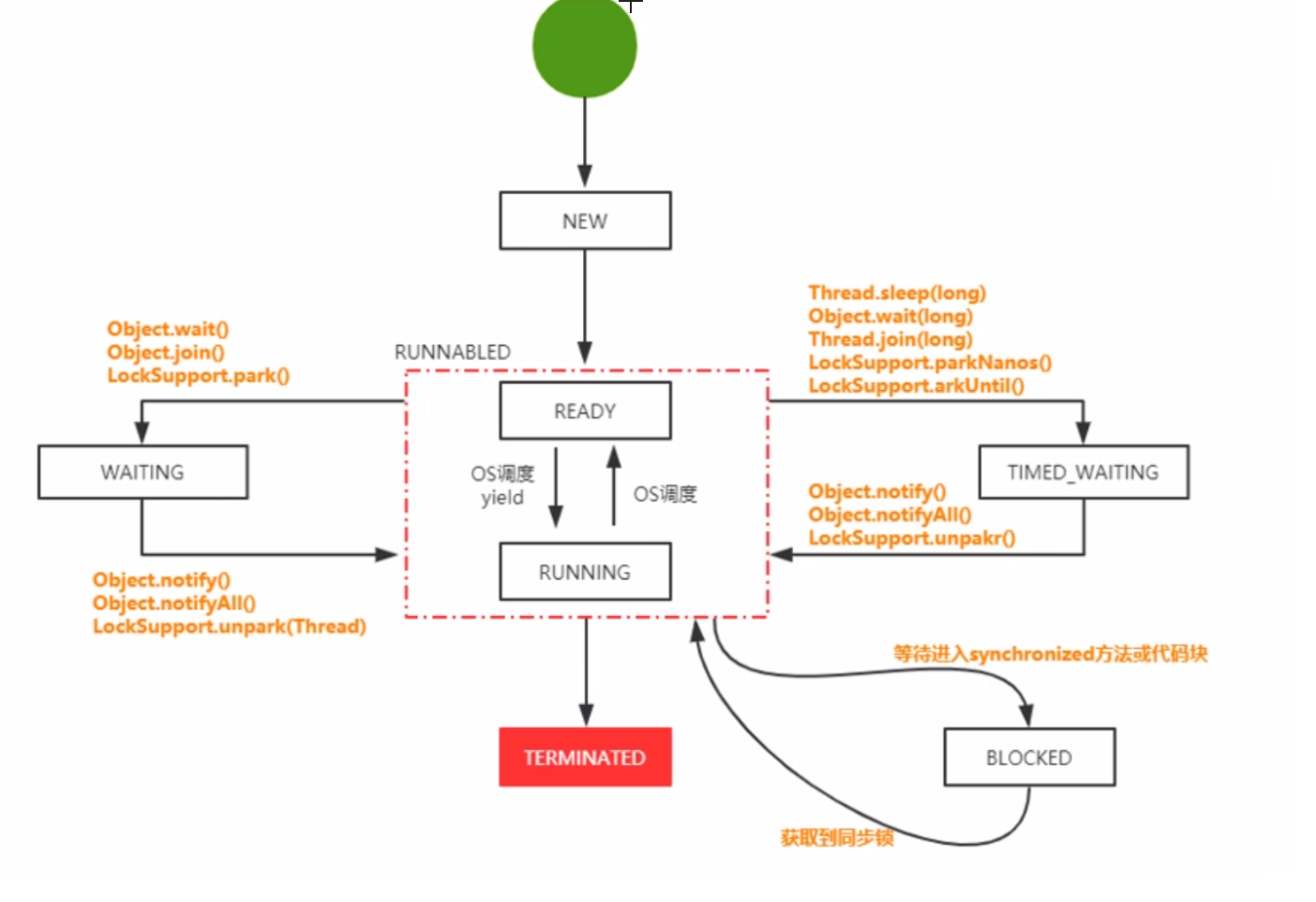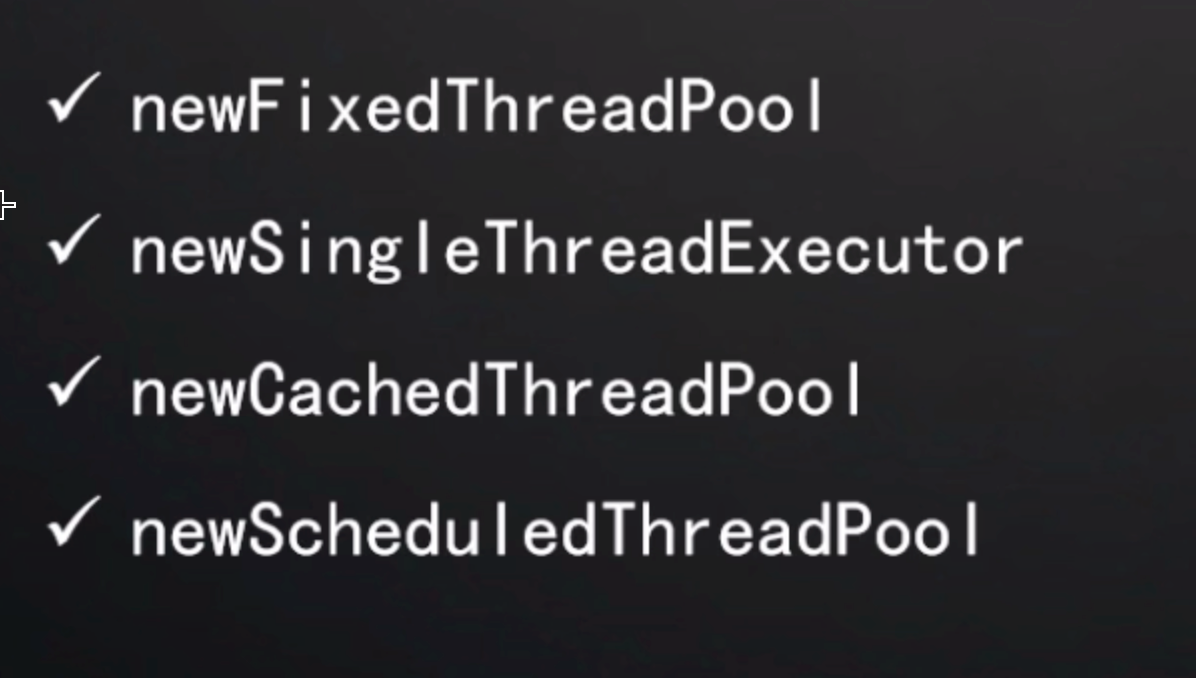多线程基础知识
所谓教条,就是生搬硬套,以开放的心态接受新概念,理解上下文,注重实践和经验。
Java的并发模型是传统的基于内存共享的并发模型
如何查看线程的状态(Jstack)
线程的生命周期
将线程比喻成人,是一种很好的理解方式,比喻成人的生老病死,人与人之间的协作,等等。

4. 线程安全问题 (原子性 可见性 有序性)
原子性 实例
public class Demo extends Thread { private static int num=100000; @Override public void run() { addNumber(); } // 如果不加synchronized 由于cpu的时间片的切换,有的减法操作丢失了他的执行权力,再次执行时数据产生偏差 [synchronized] static public void addNumber() { for (int i1 = 0; i1 < 5000; i1++) { num--; } } public static void main(String[] args) throws InterruptedException { Thread[] threads = new Thread[20]; for (int i = 0; i < threads.length; i++) { new Thread(new Demo()).start(); } System.out.println( "结果:" + num); } }
可见性 实例
public class Demo { // volatile 使flag 可以被其他线程可见 static volatile boolean flag =true; public static void main(String[] args) throws InterruptedException { new Thread(()->{ int i =0; while (flag) { i++; } } ).start(); Thread.sleep(1000); //主线程不成睡,会直接执行结束,不会显示答案 flag=false; }
有序性 实例
CPU 的编译,指令优化会破坏语句的执行顺序
synchronized 对象锁用法
-
同步方法
-
同步静态方法
synchronized static (this) {//对象 } -
同步方法块
synchronized (this) { }
synchronized 对象锁实例
public class Demo3 implements Runnable{ static int num; synchronized static void add() { // 若果不是静态的方法,每一个对象一个方法,就不是争用资源,锁不住。 for (int i = 0; i < 20000; i++) { num++; } } @Override public void run() { add(); } public static void main(String[] args) throws InterruptedException { for (int i = 0; i < 10; i++) { Thread thread = new Thread(new Demo3()); thread.start(); } Thread.sleep(2000); System.out.println(num); } }
线程的基本操作 (线程通信)
线程的三种创建方式- Callable 接口实现
public class CallableDemo implements Callable { @Override public Object call() throws Exception { return null; } @Override public void run() { System.out.println("runnable 实现的线程"); } public static void main(String[] args) throws InterruptedException, ExecutionException { ExecutorService executor = Executors.newFixedThreadPool(2); Callable callable = new CallableDemo(); Future<String> t1 = executor.submit(callable); String s = t1.get(); System.out.println("开始消费"); } }
线程的三种创建方式- 继承Thread 类
public class Threaddemo extends Thread { @Override public void run() { System.out.println("hello"); } public static void main(String[] args) { new Threaddemo().start(); } }
线程的三种创建方式- 实现runnable 接口
public class CallableDemo implements Runnable { @Override public void run() { System.out.println("runnable 实现的线程"); } public static void main(String[] args) { Thread thread = new Thread(new CallableDemo()); thread.start(); } }
join阻塞主线程实例
public class Demo3 implements Runnable{ static int num; @Override public void run() { for (int i = 0; i < 20000; i++) { num++; } } public static void main(String[] args) throws InterruptedException { for (int i = 0; i < 10; i++) { Thread thread = new Thread(new Demo3()); thread.start(); // thread.join(); //阻塞主线程,线程卓个执行 //阻塞主线程,卓个创建子线程执行,减少并发 } Thread.sleep(2000); System.out.println(num); } }
1. join 阻塞的是主线程 2. 因为多线程的执行是异步的,如果写代码时候,如果不阻塞主线程,有时候数据操作的值输出并不完整
wait notify 实例
main
public class Demo { public static void main(String[] args) throws InterruptedException { Queue<Integer> queue = new LinkedList<>(); new Thread(new Puroduce(queue,100)).start(); new Thread(new Consumer(queue,100)).start(); Thread.sleep(1000); // 生产者一直生产, 直到到达100个,停止生产,阻塞 ---》 通知消费者消费 // 消费者一直消费,没有可以消费的, 就停止消费, 阻塞;---》 通知生产者生产 } }
join 实例
interrupter 实例
yeild 实例
生产者
public class Puroduce implements Runnable { Queue<Integer> queue; private int size; public Puroduce(Queue<Integer> queue, int size) { this.queue = queue; this.size = size; } private void produce() throws Exception { int i = 0; while (true) { i++; synchronized (queue) { while (queue.size() == size) { System.out.println("已经满了"); queue.wait(); } queue.add(i); System.out.println("生产者开始生产: " + i); Thread.sleep(100); queue.notifyAll(); } } } @Override public void run() { try { produce(); } catch (Exception e) { e.printStackTrace(); } } }
消费者
public class Consumer implements Runnable { Queue<Integer> queue; private int size = 0; public Consumer(Queue<Integer> queue, int size) { this.queue = queue; this.size = size; } private void sonsume() throws Exception { int i = 0; synchronized (queue) { while (true) { i++; while (queue.isEmpty()){ System.out.println("已经消费完了"); queue.wait(); } Integer remove = queue.remove(); System.out.println("消费者开始消费: " + remove); Thread.sleep(100); queue.notifyAll(); } } } @Override public void run() { try { sonsume(); } catch (Exception e) { e.printStackTrace(); } } }
总结
synchronized 对象锁 锁住同样一个对象 让两个线程相互通信
JUC 包和AQS
什么是AQS
AQS(AbstractQueuedSynchronizer)是Java中的一个用于构建锁和同步器的框架,它是java.util.concurrent包中的核心组件之一。Doug Lea开发了AQS,它为实现依赖于先进先出(FIFO)等待队列的阻塞锁和相关的同步器(信号量、事件等)提供了一个基础框架。
AQS利用了一个整型的状态(state)变量来表示同步状态,通过内部的方法来改变这个状态,并且提供了一种高效的方式来管理线程的阻塞和唤醒。它是许多并发工具的基础,例如ReentrantLock、CountDownLatch、Semaphore、ReentrantReadWriteLock等。
AQS的工作原理:
1.状态(State): AQS使用一个整数(state)来表示同步状态,根据具体的同步器的需求,这个状态可以代表不同的意义。例如,在ReentrantLock中,状态为0表示未锁定状态,而大于0表示锁定状态,并且计数表示重入的次数。
2.等待队列: 当线程尝试获取同步状态失败时,AQS会将该线程包装成一个节点(Node)加入到等待队列中。等待队列是一个类型为Node的双向链表,用来管理所有等待获取同步状态的线程。
3.获取和释放同步状态: AQS定义了两种资源获取的方式:独占和共享。独占方式下,一个时间点只能有一个线程获取到资源。共享方式下,允许多个线程同时获取到资源。具体的同步器可以根据需求选择实现这两种方式中的一种或两种。
AQS的重要方法:
- protected boolean tryAcquire(int arg):尝试获取资源,成功则返回true,失败则返回false。
- protected boolean tryRelease(int arg):尝试释放资源,成功则返回true,失败则返回false。
- protected int tryAcquireShared(int arg):尝试获取共享资源。
- protected boolean tryReleaseShared(int arg):尝试释放共享资源。
- public final void acquire(int arg)、public final void acquireShared(int arg):调用这些方法的线程将会在获取不到资源时,被加入到等待队列中,并在条件满足时被唤醒。
AQS通过内部维护的等待队列来管理所有竞争资源的线程,当一个线程获取资源时,AQS会根据资源的状态和获取模式(独占/共享)来决定是否需要阻塞线程,当资源被释放时,会从等待队列中唤醒一个或多个线程来尝试获取资源。这个机制是构建锁和其他同步器的基础,使得开发者可以较为容易地实现安全的并发控制。
重入锁ReentrantLock
public class Demo3 implements Runnable{ static int num; static ReentrantLock lock = new ReentrantLock(); // 可以锁住非静态方法 void add() { lock.lock();// 加锁 for (int i = 0; i < 20000; i++) { num++; } lock.unlock();// 解锁 } @Override public void run() { add(); } public static void main(String[] args) throws InterruptedException { for (int i = 0; i < 10; i++) { Thread thread = new Thread(new Demo3()); thread.start(); } Thread.sleep(2000); System.out.println(num); } }
重入锁的意思,就是一个对象在访问多个争用资源时候,拿到了相同的锁之后,就不用再去获得锁 如果是共享锁,对象在访问多个争用资源的时候,获得了一个锁,别的对象没有锁不能访问该资源,而访问第二个争用资源时,又没有先释放锁,造成了死锁现象。
java 中如何使用线程池
线程池的类别

线程池的使用方法 Executors.newFixedThreadPool 实例
public class Demo4 implements Runnable{ static int num; synchronized static void add() { for (int i = 0; i < 20000; i++) { num++; } } @Override public void run() { add(); System.out.println(Thread.currentThread().getName()); } public static void main(String[] args) throws InterruptedException { ExecutorService executorService = Executors.newFixedThreadPool(2); for (int i = 0; i < 3; i++) {//启动3个任务 executorService.execute(new Demo4()); } Thread.sleep(200); System.out.println("最终结果: "+ num); executorService.shutdownNow(); } }





【推荐】国内首个AI IDE,深度理解中文开发场景,立即下载体验Trae
【推荐】编程新体验,更懂你的AI,立即体验豆包MarsCode编程助手
【推荐】抖音旗下AI助手豆包,你的智能百科全书,全免费不限次数
【推荐】轻量又高性能的 SSH 工具 IShell:AI 加持,快人一步
· 开发者必知的日志记录最佳实践
· SQL Server 2025 AI相关能力初探
· Linux系列:如何用 C#调用 C方法造成内存泄露
· AI与.NET技术实操系列(二):开始使用ML.NET
· 记一次.NET内存居高不下排查解决与启示
· 阿里最新开源QwQ-32B,效果媲美deepseek-r1满血版,部署成本又又又降低了!
· 开源Multi-agent AI智能体框架aevatar.ai,欢迎大家贡献代码
· Manus重磅发布:全球首款通用AI代理技术深度解析与实战指南
· 被坑几百块钱后,我竟然真的恢复了删除的微信聊天记录!
· AI技术革命,工作效率10个最佳AI工具